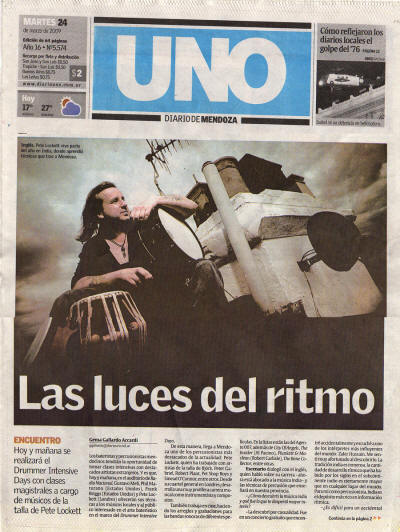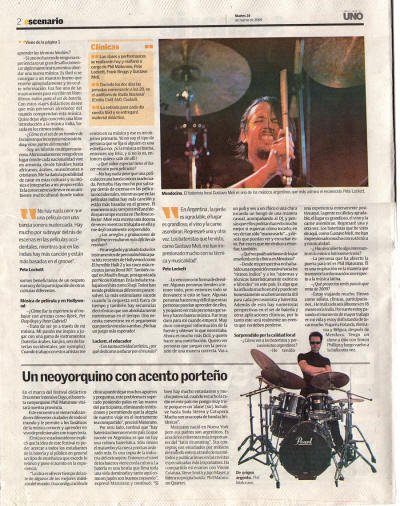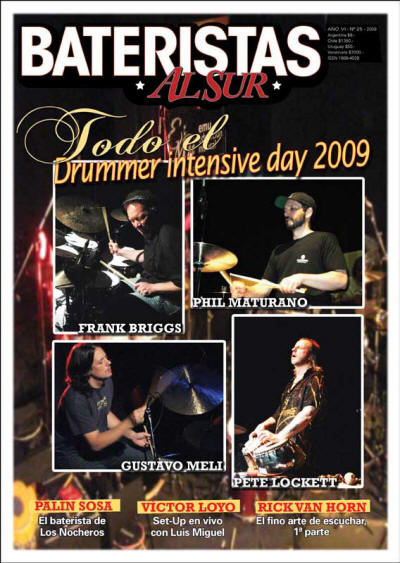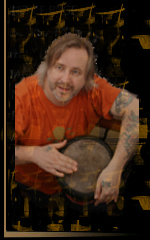|


DOWNLOAD AS PDF

Download article in Spanish as PDF
Interview
translated from Spanish;
Q. First you where a drummer...when
did you change to percussion, what made you change perhaps 180°?
Ans. It wasn’t something I ever decided to do, it just happened.
I still play drum set on sessions and my new book on Hudson
music is basically a drum set book. Originally the percussion
was to compliment my drum set playing but it became more and
more a part of what I did. Part of the reason for this was that
a lot of percussion can be practiced without blasting the
neighbors. That was a basic practical thing which meant I was
spending a lot more time on perc because I could not practice
drum set at home.
Then I started to add it to the drum set, tablas on the left of
the hi hat, bongos. Then congas in place of the floor toms etc
etc. I started using entirely different set ups for different
situations. Sometimes just perc and a bass drum. Sometimes a
Trilok style hands only kit. I got known for always turning up
with something different and having boxes of sounds and
atmospheres. On the whole, nearly everyone I worked with
preferred this approach instead of straight forward drum set. I
also got very used to having so many different sounds at my
fingertips and found I had less options when I would go back to
regular kit.
Q. How do you see drummers today? What do you think about them?
Ans. That is a big question. I am assuming you mean the overall
shape of drumming trends today. My feeling is that too many
players look to the outside for their values rather than looking
inside themselves. For me, far to many young drummers sound
similar. I really preferred it when there was less technique and
more character. Bonham, Bruford, Elvin, Gadd, Paice, Moon, Steve
Jansen, Copeland. All distinct personalities who referred to
within themselves for their values. It is kind of more like that
still in the percussion world because players are often bringing
different cultural colours together to make up their identity.
Giovanni is great for example but how many players do you hear
who play anything like him.
I feel strongly that players should bring in different colours
into their kit playing, such as Benny Grebb for example. Bear in
mind, the original traps kits were a compilation of whatever
percussion sounds were around at the time. There was no hard
line distinction between drummer and percussionist as there is
today.
Q. How long have you 've been making clinics? You have some drum
books edited, how and when did you started to write? Not every
percusionist/drummer knows how to put the ideas together to make
a book.
I don’t really think of them as clinics in that way. I try to
make them educational performances. Wherever time permits I try
to explain some of the techniques and rhythmic structures etc.
My primary objective is to entertain, educate and hopefully
inspire. I see that as my responsibility. Out of that
responsibility I have developed an educational method which is
delivered with clarity and without needless complications,
jargon and confusion. I think too many people are happy to take
the educational responsibility lightly and are more concerned
with showing how great they are and how impossibly difficult it
all is. I don’t for a second suggest that achieving excellence
on an instrument is easy. I would categorically state though
that it is along an orderly and logical path that all these
performers develop their skills and it is for us to unearth that
path and reveal it to those wishing to travel that way.
Q. How did you react when you received the invitation to come to
Argentina, What did you know about us?
Ans. I am always excited about going to a country for the first
time. Argentina was filled with mystery for me. I had no idea
what to expect. I was really happy to find out what a great
place it was, the people, the climate, the food, wine and
culture. To me it combines the best of countries like Italy and
Spain along with the positive aspects of a place like LA.
Q. What was it you wanted to show the drummers and the students
down here? Did you? What do you think?
Ans. There has not been a massive amount of exposure to some of
the Indian rhythms etc so that was my main focus. It is such a
rich rhythmic tradition and is such a useful tool for any
musician to employ. Pointing the way to start orchestrating this
stuff on other percussion is also a vital core of what I was
showing.
Q. How was the experience to work with Phil and Frank and what
do you think about Jota and Gustavo?
Ans. It is always great to hang with drummers over a period of
time like this. All such great players but all so different. It
is great to see such a varied line up and hopefully it opened up
peoples eyes to the infinite possibilities in drum set and
percussion. The participants were great. They all helped make it
such a positive experience.
Q. Tell us about your last works and about your new book.
The book came about over a long period of time as I’d been
trying to apply the Indian knowledge to the drum set and it took
me many years to do that, to find ways of articulating those
rhythms onto the drum set. Slowly it came about through other
percussion instruments as everything become ‘one’ and stopped
being separate instruments in my mind and I began to think of
them as a family of instruments which is why I call myself a
multi-percussionist. I was teaching the South Indian rhythmic
system and that became the core of the book. Once I had my
approach to the system in place I was able to approach the
system in a slightly more abstract way so that the building
blocks could be utilized by all musicians. I give people the
building blocks and would then move on to whole compositions. I
got a lot of positive feedback from students using this method.
They could understand and perceive the building blocks and then
see how they were built into the larger compositions and themes.
The next logical step was to articulate it onto the drums.
Really, the book gives you two things, there is the system that
can be for everyone and then there is the application for the
drum set. The book contains the South Indian syllables /
building blocks and the rhythmic structures and then the
applications for anybody to use. I wanted to model the book on
the book that covered African drumming on the drum set where the
first big chunk is the history, the drums, the idiomatic setting
and then the extrapolations on the drum set. I believe it is a
book that will last a long time and is not a moment of fashion
that won’t be of interest in five years. The whole development
of the book came from the education method so it is kind of
organic in that way. It never started out to be a book, but it
ended up being one!
Regarding current stuff. After Argentina it was straight to
Frankfurt for solo performances on the main stage, a duo with
Dave Langguth and also a guest performance with Selva Ganesh,
Jonas Hellborg and Niladri Kumar. Then it was a solo slot at the
Adams drum festival in Belgium and also a duo slot with Simon
Phillips. This was followed by a short clinic tour in Holland.
Around this time my new book received 5 stars in Modern Drummer
magazine. I was also featured around this time on Jon Hassell's
new release on ECM, 'Last night the moon came dropping its
clothes in the street'
Before that It was India for the launch tour of my new album
with Bickram Ghosh. The album, entitled 'Kingdom of Rhythm' came
out on the HMV / Saregama label and was launched in Kolkatta by
the governor of Bengal along with a sold out concert featuring
flame throwers and fire dancers. The show was broadcast live on
TV. This is one of seven albums I have recorded in India in the
last two years. Five have been released so far. Numerous
projects are in the pipeline. I have just started work on an
album with Mark Schullman. The first track will be featured on
his forthcoming DVD release. This and much, much more. I feel
very grateful to be doing so much music that is really close to
my heart.


|

